Total Solar Eclipse Observing Report August 21, 2017
By Bill Breeden
Like many amateur astronomers, I requested a vacation day from work over a year ago. I renewed the request this past January 2, in anticipation of the Big Day: The Total Solar Eclipse of August 21, 2017.
The St. Louis Astronomical Society had no official eclipse observing site or plans, allowing members to observe it on their own with family and friends. The River Bend Astronomy Club, of which I am also a member, made plans to observe the eclipse from a private location near Chester, Illinois. This location was ideal: Unobstructed views all around, rolling hills to the northwest to view the incoming Moon’s shadow, and 2 minutes 38 seconds of Totality. Traffic and weather would be our only worries on Eclipse Day.
I purchased a Daystar solar filter for my Canon T4i camera, and I already have an 8-inch solar filter for my Schmidt-Cassegrain telescope. I ordered eclipse glasses from Rainbow Symphony, so Rita and I were certainly prepared as far as solar filters were concerned. Despite everything I had read that said “don’t waste time trying to take pictures of the eclipse,” I was determined to capture some images or video, at least passively, while enjoying the eclipse. How hard could it be? Point a (solar filtered) video camera at the Sun, hit record, and enjoy.
So I brought my telescope, solar filter, Canon camera, tripod, and Daystar solar filter to the Science Center on August 4. This time of year, the Sun sets well after we arrive at the Planetarium, so there was time to practice taking photos and videos of the Sun just to see how they would turn out. Although more cumbersome than I expected, my photos (and videos) turned out quite nice. Through the Daystar solar filter, sunspots were easily visible in my pictures and videos. I also had my Thousand Oaks solar filter attached to the telescope, and enjoyed white-light filtered views of the Sun. Visitors also enjoyed the view.
I conducted my second field photo test on August 19. I brought my camera and Daystar solar filter to a local park to give it another go. This time, the Sun was at a high angle as it would be during the eclipse, which introduced another difficulty: getting the Sun in sights while craning upward, and trying not to accidentally look right at the Sun while doing so. A jacket draped over my head and camera helped tremendously in that regard. Thanks to Cook for that suggestion! I took many pictures of the Sun during this test, over the course of about one hour. That was enough time for the Sun to move, and to require me to nudge the camera between shots to keep the Sun centered. I was using a Canon 75-300mm lens, and I tested shots at 75, 135, 200, and 300mm.
Once I returned home, I uploaded these images and viewed them on a large TV. I learned several things:
(1) The images taken with manual focus are better than automatic focus, (2) centering the Sun’s image in the frame makes for a much more pleasing picture, and (3) 200mm seemed to be the sweet spot between image size and managing drift with the tripod.
My plan was now quite simple: On Eclipse Day, I would set up my Canon T4i on its tripod with the Daystar solar filter attached, and point it sunward. Then I would simply wait until First Contact, and snap a photo of the partially eclipsed Sun every 10 minutes. Meanwhile, my wife and I would each carry a camera and snap candid photos of the event, the people, and yes, the Sun during Totality. My SCT with its Thousand Oaks solar filter would track the Sun and Moon for us to enjoy periodic views of the partially eclipsed Sun between First and Second Contact. The telescope would not be used for photography.
The Sunday before Eclipse Day (August 20) was a day of anticipation, worry, planning, charging batteries, packing, rehearsing our trip route, and getting extra sleep. I was nearly obsessed with checking the weather forecast for several locations. For any run-of-the-mill star party (which they all are now after going through this turmoil), there are two weather forecasts I can deal with: Clear skies (yes!) or Overcast (forget it; a.k.a., there is no chance of missing anything). But a forecast of 50% cloud cover is pure torture. To me, this is the weather service saying, “We have no idea what to expect.” As the day wore on, the forecast stubbornly did not budge.
By 6pm on August 20, here were the cloud cover forecasts for Monday, August 21, at 1pm:
Danville: 60% cloud cover
My own back yard: 50% cloud cover
Columbia, MO: 60% cloud cover
Festus: 45% cloud cover
Chester, IL: 45% cloud cover
Arghh! How can anyone make any plans with these numbers? My plan was simple: All things being equal, head to Chester. But if the weather dictated significant advantages in another direction, then we would head that way, even if that meant staying home for only 57 seconds of Totality.
Chester was our choice for betting on clear skies. With south and south-east locations faring modestly better (barely), we chose to stick to our plans and head to River Bend Astronomy Club’s designated eclipse site. I planned our driving route so that it would be completely within the path of Totality; if we had any problems at all, we would still not miss the eclipse. Now our only worry would be clouds.
Eclipse Day
We awoke on Monday morning at 3:30 am, packed our gear and food, and left home about 5:30 am. Our route to Chester was I-255 across the river to Route 3, then to Route 154 and Route 4. It was still dark outside, with sunrise expected at 6:19 am. Once en route, we made it to Columbia, Illinois by sunrise. The sky was nearly completely clear, with a few wispy clouds in the distance. So far, the sky was cooperating, and the traffic was not an issue.
I am not a coffee drinker, but I needed some caffeine. We stopped in Steeleville at a convenience store for a fountain soda, and sausage and egg biscuits for breakfast. It was now 7:00 am, and we ate our breakfast in the car and looked at the sky: It was much clearer than the weather forecast would have had us believe, or else we were under a very large clearing. Either way, we just hoped it would last for another seven hours or so!
We left Steeleville, and traveled to a farm near Chester, Illinois to River Bend’s eclipse viewing site. It was about 7:30 am, and we were the first to arrive. The sky still looked terrific, and I snapped a picture of it for good luck. The temperature was about 80 degrees, with a light breeze.

Our sky at 7:33 am looking in the direction the Sun would be at eclipse time. Looking good!
Image Credit : Bill Breeden
Other people began arriving, including the event’s coordinators, Jeff and Terry. Rita and I helped with placing orange cones, erecting shade canopies, setting up tables, and setting up an area with a white tarp for viewing shadow bands. The temperature climbed to the upper 80s by this time. River Bend members would be present, along with the farmers’ family and friends, so we anticipated about 100 people. They would be spread out over a large field, providing for camaraderie or solitude, whichever people preferred. Rita and I prefer a mix of each – a few people around to share the excitement with, but not so many as to be a distraction.
By 10:30 am, we had finished helping with the event set-up, so it was time to begin setting up our own area. As I set up my tables, chairs, telescope, and camera, I spent a moment to take this all in: If the sky stays clear like this, we will see a Total Eclipse of the Sun today. I could hardly stand the anticipation! Of all the planets, stars, double stars, star clusters, and galaxies I had seen at night, the very idea of seeing my first Total Solar Eclipse was unbelievable, and it wasn’t even First Contact yet!
Rita set up our tables, chairs, and food, while I set up the telescope and camera. I set up my LX90, Televue Panoptic 24mm eyepiece, and Thousand Oaks solar filter. This would be used for visual observing only rather than photography. I do not profess to be an astro-photographer, and today was not the day to start! This telescope would provide awesome views of the Sun after First Contact, with the Moon slowly creeping across the Sun’s disk. This would also give me something to show others, as a “distraction” from me and my camera.
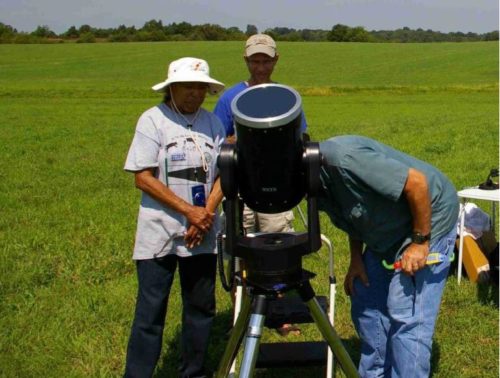
Rita minds our LX90 after setting up our viewing area.
image credit : Bill Breeden
Next, I set up my Canon T4i camera and tripod, and attached my Daystar solar filter. Using a white towel to block the sun, I pointed the camera sunward and snapped a few photos. The Sun’s yellowish disk (still full) looked nice on the LCD screen, so “mission accomplished” at this point. At First Contact and until Totality, I would simply snap two pictures every 10 minutes.
Several River Bend members, and their family and friends, stopped by to take a look at the Sun through the LX90. Even with the Sun showing a full disk, several “oohs” and “ahhs” were expressed. “Just wait until First Contact!” I said. By this time, the temperature had climbed to about 90 degrees.
First Contact: 11:51:31 am (the Moon first appears to creep in front of the Sun)
Second Contact: 1:19:05 pm (Totality begins)
Third Contact: 1:21:43 pm (Totality ends)
Fourth Contact: 2:46:33 pm (the Moon ends its journey across the face of the Sun)
First Contact
Then it began.
At 11:51 am, I walked over to my telescope to take a look at the filtered view of the Sun. I looked and looked. In the upper-right corner of the Sun, there was a hint of a dent in the disk. If this was First Contact, the times we got from the eclipse web site were spot-on! I looked again just a half-minute later and there it was: An unmistakable small bite out of the upper-right corner of the Sun! (The view is reversed in my LX90.) I yelled “First Contact!”, startling anyone near us. Rita took a look and saw it. “Wow! I see something near the top-right!”
“You are seeing the Moon begin its journey across the Sun. The Eclipse has officially begun!” I said.
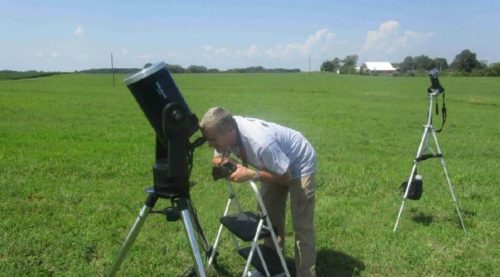
I am enjoying a view of First Contact through my LX90 SCT with solar filter.
image credit : Rita Breeden
My exclamation attracted several members and their children to my telescope. While they were wowed with First Contact, I attended to my Canon camera and took four photos. This only required a quick tweak of the camera position in alt/az to center the Sun, and click, click, click, click. Since the small notch of the Moon was hard to see, I snapped two more photos 5 minutes later. Now, all I needed to do was repeat this process every 10 minutes or so until Totality.
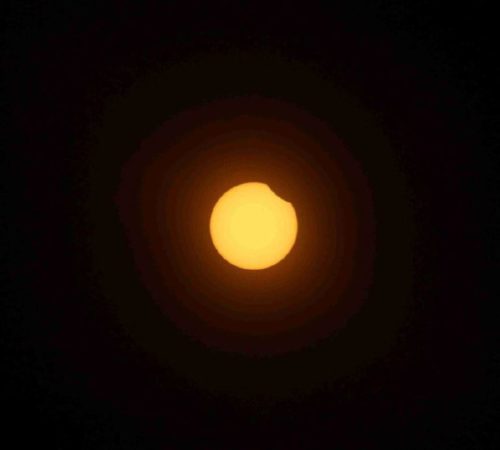
Five minutes after First Contact, 11:56 am.
image credit : Bill Breeden
About 15 minutes after First Contact, the “bite” out of the Sun by our Moon was quickly getting larger. At this point, I actually grew a little sad; the eclipse, even this partial phase, was going by so fast! A few people stepped up to my LX90 for a look. “Wow, the Moon is getting so big in front of the Sun!” someone said, excitedly.
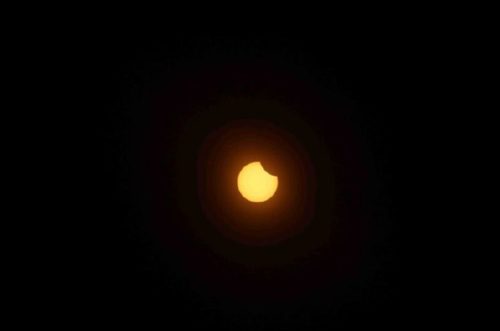
Fourteen minutes after First Contact, 12:05 pm.
image credit : Bill Breeden
12:09 pm – it was time to take some more photos. Click, click with the camera.
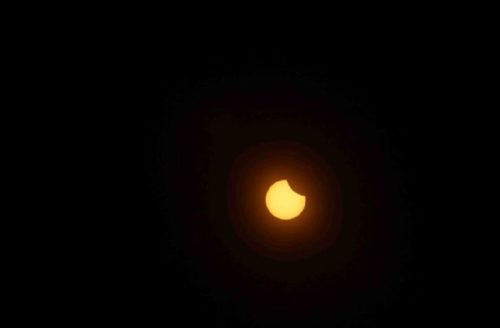
Eighteen minutes after First Contact, 12:09 pm.
image credit : Bill Breeden
By 12:44 pm, the Moon covered about half of the Sun’s disk. The view through eclipse glasses was amazing, and the close-up view through our LX90 was breath-taking! There it was – the Sun – looking like a very, very, bright yellow crescent “Moon” through my 24mm Panoptic eyepiece. Most other people were enjoying their views through eclipse glasses, but we still had a few people come up to look through the telescope at the amazing partially-eclipsed Sun!
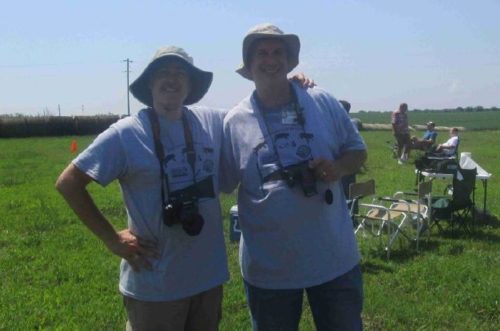
Jeff and Bill pose for Rita’s camera!
image credit : Rita Breeden
Small images of the partially eclipsed Sun are visible on a white tarp spread out on the ground, in the shadow of this colander, 12:31 pm.
image credit : Bill Breeden
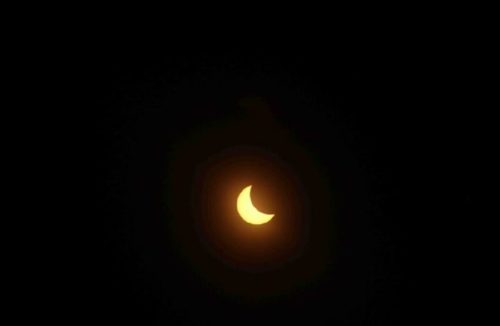
Fifty-three minutes after First Contact, 12:44 pm.
image credit : Bill Breeden
1:00 pm rolled around, and excitement over the imminent Total Solar Eclipse was beginning to mount. (As if I wasn’t already over-excited!) Through eclipse glasses and our LX90, the Sun was now reduced to a thin crescent. The sunlit daytime felt strange, somewhat dim, and laser-focused. Rita and I walked around the field before 1:00 pm, and pointed out everyone’s sharp shadow on the ground. Your shadow is normally a bit fuzzy around the edges, but not now. Sharp as a silhouette! Trees in the distance looked clearer than usual, and there was just an uneasy feeling about the sunlight that I cannot accurately describe.
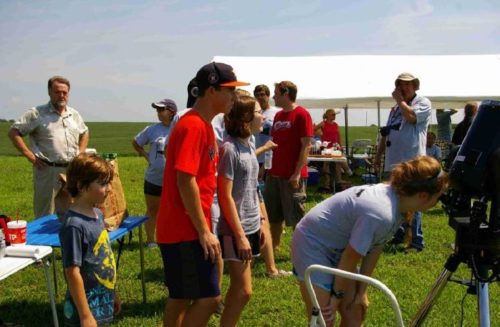
People line up for a glimpse of the deep partial phase of the eclipse, 12:54 pm. Shadows were very sharp by this time.
image credit : Bill Breeden
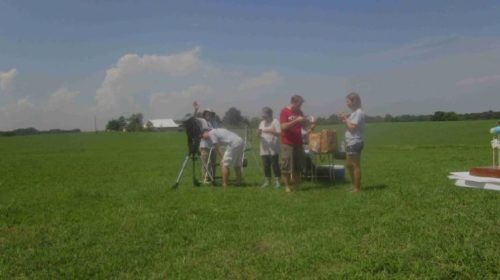
The sunlit daytime sky has an eerie uneasy quality about it. 12:56 pm.
image credit : Rita Breeden
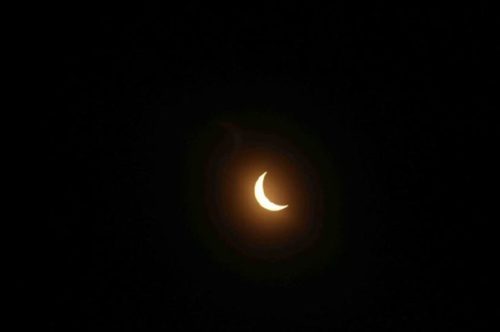
One hour and eight minutes after First Contact, twenty-two minutes before Totality, 12:59 pm.
image credit : Bill Breeden
The minutes after 1:00 pm are sort of a blur to me. I didn’t want to miss anything, and I had to constantly choose between looking at the Sun through the LX90, adjusting the camera to shoot another photo, looking around the landscape to notice the changing and fading daylight, and making sure Rita did not miss anything either. Decisions, decisions! Who knew that a Total Solar Eclipse could be so stressful! By 1:10 pm, the crescent of the Sun was growing ever more slender, and this was the time that I knew that this eclipse would wait for no one and nothing. It was happening whether we were ready or not.
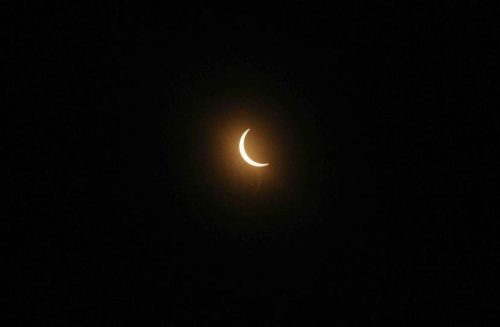
Eleven minutes before Totality, 1:10 pm.
image credit : Bill Breeden
At 1:14 pm, I snapped my last picture of the Sun before Totality. There was no time to waste now fiddling with the camera. At 1:17 pm, I started a video with my cell phone pointed west-northwest to catch the Moon’s shadow approaching (and our reactions to Totality). At 1:19pm, I started the Canon camera in video mode to capture the last of the Sun’s rays before Totality.
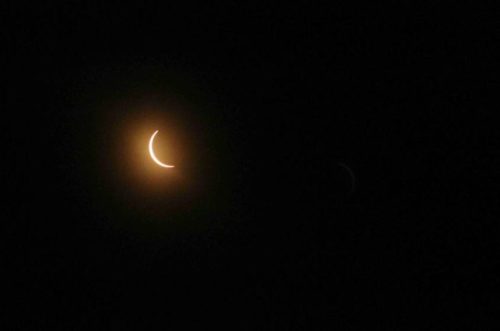
Seven minutes before Totality, 1:14 pm.
image credit : Bill Breeden
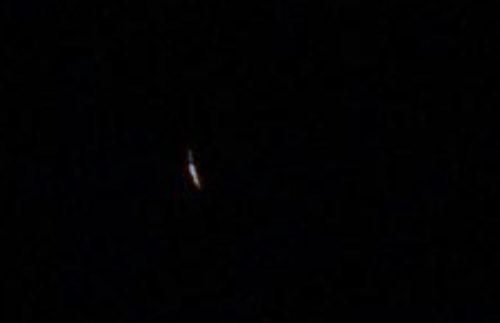
Bailey’s Beads, 5 seconds before Totality, 1:21 pm.
image credit : Bill Breeden
Totality
Just minutes before Second Contact (Totality), my wife Rita sat comfortably in her chair, staring at the Sun through her eclipse glasses, and I was looking west-northwest to see if I could see the Moon’s shadow approaching. As I looked into the distance, the darkening became frighteningly obvious. All I could say was “Rita, Rita, come here, get up! Get up! I got Rita up to see the approaching darkness, then we turned around at that instant to look up at the Sun.
Silence.
There it was, a Total Solar Eclipse. The Sun’s corona. A dark-blue sky. A shimmering, silver ring with flame-like silver strings reaching in all directions around a jet-black hole in the sky.
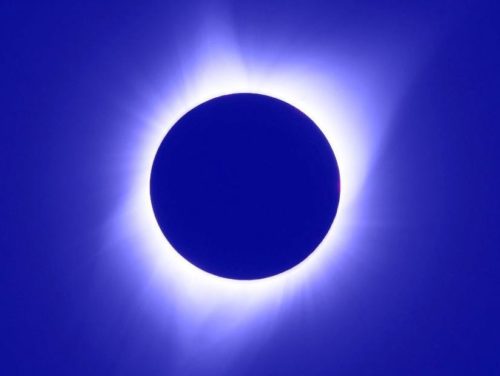
The wonderful folks at NASA provided this picture of Totality.
Image credit: Aubrey Gemignani/NASA
“You won’t see it through the telescope!! Look at the Sun!” I said, much too loudly, to people wasting precious seconds walking up to my telescope. “Look at the Sun! Naked eye! The whole while, Rita and I stared, trans-fixed, frozen, awestruck. Tears fell. Time stood still.
People shouted. I shouted. Rita kept her cool with an ear-to-ear smile. I was literally breathless at the sight. Crickets sang. Bats flew overhead. It gives me goose bumps just to write about it.
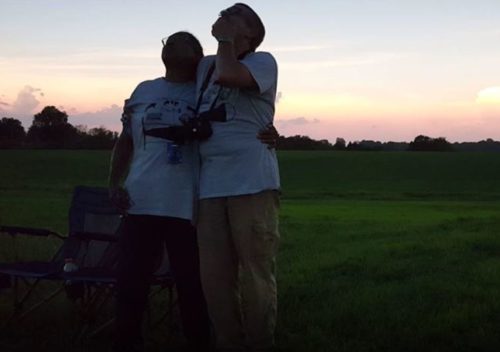
My wife and I stare in awe at Totality. 1:21 pm.
image credit : Bill Breeden
In every direction around us, the yellow and orange horizon presented the famous 360-degree sunset that I have only read about until this moment. We quickly turned our gaze back to the Sun, and silvery corona still hanging in the sky around a perfectly round black Moon. Did it last forever, or only for a second? Both, it seems. Although Totality was short, in my mind it is still there, silver, black, surrounded by dark-blue sky, planets, and stars. The only object I took the time to identify was Venus, to the right of the eclipsed Sun. My best estimate of the brightness of the eclipsed Sun and corona would be -16. I think it was brighter than a Full Moon.
Suddenly, a bright spot appeared at the upper-right of the black disk of the Moon. This bright spot was like a beautiful red rose opening up, but much, much brighter. This was the Diamond Ring, and it was the most gorgeous thing either of us have ever seen. Rita began jumping up and down for joy, and I shouted “Diamond Ring! Diamond Ring!” It only lasted for (maybe) two seconds. To me, it looked three-dimensional, as the light from the “rose” (diamond) grew brighter, the Sun’s light seems to come right at me. The “ring” part of the Diamond Ring was very thin around the Moon, and the effect was nothing short of brilliant. I estimated the brightness of the Diamond Ring at -19 before I turned away. The daytime seemed to return much faster than it had faded just before Totality. It was time to put our eclipse glasses back on. Third Contact had arrived.
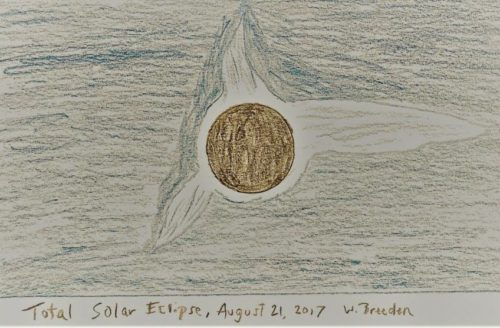
Once I returned home, I did the best I could to sketch what I saw during Totality.
image credit : Bill Breeden
Third Contact
The Sun now appeared as a thin crescent on the right side, growing larger. Third Contact had arrived. Through the LX90, the thin crescent of the Sun, and the now-receding Moon, was a very nice sight indeed, but also a melancholy reminder of just how short and rare a Total Solar Eclipse is.
I then approached my Canon camera, dutifully recording the eclipse since just before Totality. The camera’s screen showed a thin crescent Sun, this time on the right side as the Moon slowly receded. I had been so captivated by Totality, that I did not remove the Daystar solar filter. Upon watching my video later, Rita and I watched the Sun’s disk shrink to nothing, then total darkness during Totality as we heard our reactions, then the Sun’s disk return on the right side. I had the focus perfect, and the Sun placed into the frame so that the entire event stayed in camera. Interestingly, when watching the video, the time between the last sliver of visible sunlight and the reappearance of the Sun was 2 minutes and 38.5 seconds. Outstanding!
The important thing is that my wife and I saw a Total Eclipse of the Sun, together, under clear skies. Totality is the most beautiful thing we have ever seen in our entire lives, and we saw it under clear skies. What more can one ask for? It was like the Grand Canyon; pictures do not do justice to it, so you must see it for yourself.
After Third Contact, the Moon continued its march to the east, slowly revealing the Sun’ disk.
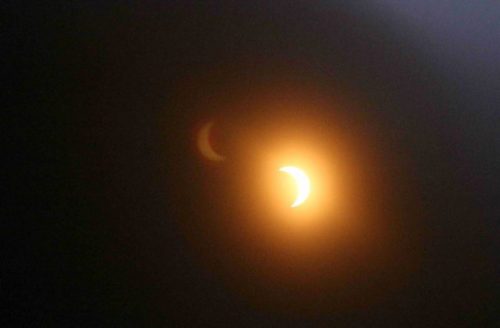
Twenty-one minutes after Third Contact, 1:45 pm.
image credit : Bill Breeden
By 2:00 pm, people were beginning to pack up. The temperature was in the mid-90s, and with the excitement of Totality behind us, we were feeling the heat of the day. Cold water helped while we packed up cameras, telescope, tables, chairs, and food. Once we were packed, Rita and I helped take down the shade canopies and pack up River Bend’s event gear.
Here is some well-earned advice about photographing a Total Solar Eclipse: If it is your first one, and you are not an experienced astro-photographer, don’t bother. Just enjoy the experience without the hassle and worry. It is more difficult than you think it will be, especially for someone like me – with little experience in astro-photography. Although I had practiced, and set up my equipment so I would not have to fiddle with it (much), I was “totally” (pun intended) mesmerized by Totality. Rita and I both had cameras on lanyards, my Canon T4i camera was busy recording video, and my cell phone was pointing west-northwest recording the Moon’s shadow approaching (and our reactions to Totality). Actually, that video is quite good. When I saw the Moon’s shadow and that darkness approaching, all I could think about was making sure Rita and I watched Totality. And we did. All 2 minutes and 38 seconds of it under clear skies. With our own eyes. It was worth it!
A big Thank You to Jeff and Terry of River Bend Astronomy Club for organizing this event, and to the farmers for allowing us to view the eclipse on their land.
The Total Solar Eclipse of August 21, 2017 is now behind us, but it leaves us with vivid memories of the most gorgeous thing we have ever seen with our own eyes. Everything was absolutely perfect, and we feel privileged to have had clear skies for the duration of the eclipse. So, Rita and I will tell others that it is true: A Total Eclipse of the Sun is the most gorgeous thing that an amateur astronomer, or anyone for that matter, will ever see.
Clear Skies,
Bill and Rita Breeden


